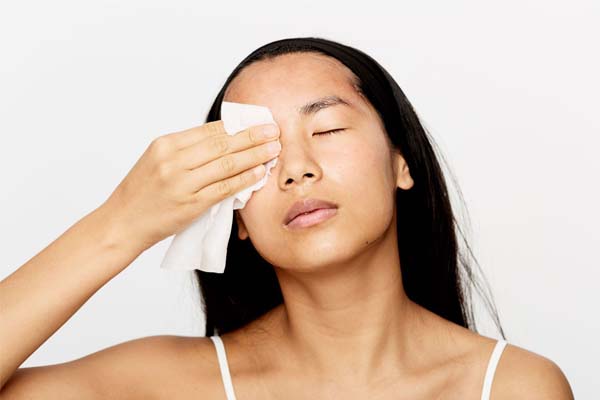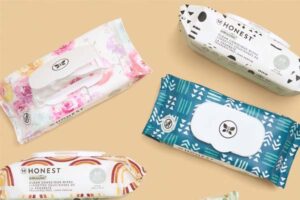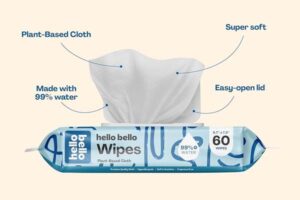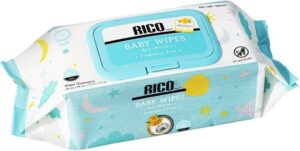
Feeling grimy but no sink nearby? You might reach for a wet wipe. But is it truly safe for your delicate facial skin? Let's find out.
Yes, you can use wet wipes on your face, but only if they are specifically designed for facial use. Avoid harsh antibacterial or general cleaning wipes, as these can irritate your skin and strip natural oils.
Using the right wet wipe on your face can be a convenient way to freshen up. Many people use them to remove makeup, dirt, or sweat when they're on the go. However, not all wet wipes are created equal. Some wipes contain ingredients like alcohol or strong fragrances. These can be too harsh for the sensitive skin on your face. This can lead to dryness, redness, or even allergic reactions. It's important to choose wipes that are labeled as hypoallergenic1, pH-balanced, and formulated for facial skin. These types of wipes are generally gentler and often include soothing ingredients.
When choosing a facial wipe, look for beneficial ingredients. Things like aloe vera, chamomile, or hyaluronic acid can help soothe and hydrate your skin. On the other hand, try to avoid wipes with high concentrations of alcohol, parabens, sulfates, and artificial fragrances. These can be culprits for skin irritation. While facial wipes are great for occasional use, like after a gym session or during travel, they shouldn't completely replace your regular face-washing routine with a cleanser and water. A proper cleanse is more effective at removing all impurities.
Can You Wipe Laptop Screen With Wet Wipes?
Your laptop screen gets dusty and smudged. It's tempting to grab any wet wipe. But is that a good idea for your tech?
No, you generally should not use standard wet wipes, especially disinfectant or baby wipes, on a laptop screen. They often contain chemicals like alcohol or ammonia that can damage the screen's coating over time.

Most common wet wipes, like those for hands or surfaces, are not made for delicate electronics. Laptop screens, especially modern LCD or OLED ones, have sensitive coatings. These coatings can be anti-glare or protective layers. Using the wrong chemicals can lead to streaks, cloudiness, or even permanent damage to these coatings. Think of it like using a harsh kitchen cleaner on a pair of expensive eyeglasses – you just wouldn't.
Why Standard Wipes Aren't Screen-Friendly
Let's break down why many common wet wipes are a bad match for your laptop screen:
-
Harsh Chemicals:
- Alcohol (Isopropyl or Ethanol): While great for disinfecting, high concentrations can dry out and damage screen coatings. Some specialized electronic wipes use a very low, controlled percentage of isopropyl alcohol, but general-purpose wipes often have too much.
- Ammonia: Frequently found in glass cleaners, ammonia is very aggressive and can strip anti-reflective coatings.
- Bleach and Other Disinfectants: These are far too strong for electronic screens and can cause significant damage.
- Fragrances and Dyes: These add unnecessary chemicals that can leave residue or react with the screen surface.
-
Abrasive Materials:
- Some wipes have a rougher texture designed for scrubbing. This can physically scratch the delicate surface of a laptop screen.
-
Excessive Moisture:
- Wet wipes can be too damp. Liquid seeping into the edges of the screen or keyboard can cause serious internal damage.
So, How Should You Clean Your Laptop Screen Safely?
If standard wet wipes are out, what are the safe options?
-
Microfiber Cloth (Dry): For light dust and fingerprints, a dry microfiber cloth2 is often all you need. These cloths are soft and designed to trap dust without scratching. Wipe gently in a circular or side-to-side motion.
-
Microfiber Cloth (Slightly Dampened with Distilled Water):
- Power Down: Always turn off and unplug your laptop first.
- Use Distilled Water: Tap water can contain minerals that leave residue.
- Dampen, Don't Soak: Lightly spray distilled water onto the microfiber cloth, not directly onto the screen. The cloth should be barely damp, not wet.
- Wipe Gently: Use minimal pressure.
-
Specialized Electronic Screen Wipes:
- These are specifically formulated to be safe for screens. They are usually pre-moistened with a safe cleaning solution (often alcohol-free or with very low, specific alcohol content) and made from non-abrasive material.
- Always check the product label to ensure it's suitable for LCD or your specific screen type.
Here's a quick comparison:
| Cleaning Method | Safe for Screens? | Key Considerations |
|---|---|---|
| Standard Wet Wipes | No | Harsh chemicals, abrasive, too much moisture |
| Baby Wipes | No | Usually contain oils/lotions, can leave residue |
| Disinfectant Wipes | Absolutely No | Very harsh chemicals, will damage screen |
| Dry Microfiber Cloth | Yes | Best for light dust, fingerprints |
| Damp Microfiber (Distilled Water) | Yes | For tougher spots, cloth must be lightly dampened |
| Screen-Specific Wipes | Yes | Formulated for electronics, check ingredients |
Remember, gentle is the keyword when cleaning your tech.
Do Wet Ones Wipes Kill Norovirus?
Norovirus3 is a nasty bug causing stomach flu. Many people wonder if their trusty Wet Ones wipes can stop it. Let's look into this.
Standard Wet Ones antibacterial hand wipes (like the red or yellow canister) are generally not effective against norovirus. Norovirus is a non-enveloped virus, making it harder to kill than many bacteria or enveloped viruses.

Norovirus is known for being highly contagious and resilient. While many antibacterial wipes are good at killing bacteria and some common viruses (like flu, which is an enveloped virus), norovirus presents a tougher challenge. The structure of non-enveloped viruses like norovirus means they lack an outer fatty layer (envelope) that many disinfectants target. This makes them resistant to alcohol-based sanitizers and many common disinfectant wipes unless the product specifically states it is effective against norovirus.
Understanding Norovirus and Disinfection
To really get why standard wipes often fail against norovirus, we need to look at a few things:
-
What is Norovirus?
- It's a leading cause of gastroenteritis (stomach flu) worldwide.
- It spreads very easily through contaminated food, water, surfaces, or direct contact with an infected person.
- It's a "non-enveloped" virus, meaning its genetic material is protected by a tough protein shell called a capsid. Enveloped viruses (like influenza or coronaviruses) have an outer lipid membrane that is more easily disrupted by disinfectants like alcohol.
-
Why Standard Antibacterial Wipes Often Don't Work on Norovirus:
- Many Wet Ones products, particularly the common antibacterial hand wipes, rely on benzalkonium chloride as their active ingredient. While this is effective against many bacteria and some enveloped viruses, it's generally not sufficient to inactivate norovirus.
- Alcohol-based hand sanitizers need a high concentration of alcohol (typically 60-95%) to have some effect, and even then, they are considered less effective than thorough handwashing or specific virucidal disinfectants against norovirus.
What Actually Works Against Norovirus?
If you're dealing with a potential norovirus contamination, you need products with proven efficacy.
-
Bleach Solutions:
- A freshly prepared solution of household bleach (sodium hypochlorite) is highly effective. The CDC often recommends specific concentrations for surface disinfection (e.g., 1000–5000 ppm, or about 1/4 cup to 1.5 cups of 5.25%–8.25% bleach per gallon of water, depending on the surface).
- Always use with good ventilation and follow safety precautions.
-
EPA-Registered Disinfectants Effective Against Norovirus:
- Look for products on the EPA's List G (for Norovirus) or List N (for emerging viral pathogens, often including Norovirus surrogates). These products have been tested and proven effective.
- The active ingredients might include hydrogen peroxide, quaternary ammonium compounds (at higher concentrations and specific formulations), or phenolic compounds.
- Crucially, check the label: It must explicitly state "effective against norovirus" or list it as a target pathogen, and you must follow the specified contact time (how long the surface needs to stay wet with the disinfectant).
-
Handwashing:
- For personal hygiene, vigorous handwashing with soap and running water for at least 20 seconds is the most effective way to physically remove norovirus particles from your hands. Hand sanitizers are a secondary option if soap and water are unavailable, but not the first line of defense against norovirus.
Here's a table to clarify:
| Product Type | Active Ingredient (Common) | Effective Against Norovirus? | Notes |
|---|---|---|---|
| Wet Ones (Red/Yellow Canister) | Benzalkonium Chloride | Generally No | Primarily antibacterial. |
| Alcohol-Based Hand Sanitizers | 60-95% Ethanol/Isopropanol | Less Effective/Variable | Handwashing is superior. Some virucidal effect at high concentration. |
| Bleach Solution | Sodium Hypochlorite | Yes | Follow CDC guidelines for dilution and safety. |
| EPA List G/N Disinfectants | Various (e.g., H₂O₂, specific quats) | Yes (if listed) | Check label for norovirus claim & contact time. |
So, while Wet Ones are convenient for general hand cleaning, don't rely on the standard ones for norovirus protection. You need to step up to stronger, specifically indicated disinfectants for that.
Your Partner for Specialized Wet Wipe Solutions
As you can see, not all wet wipes are suitable for every situation. Whether it's gentle facial care, safe screen cleaning, or effective disinfection against tough viruses like norovirus, the right formulation and material are key.
This is where we at BBWIPES® come in. With over 12 years of experience, we specialize in creating premium, custom wet wipe solutions. Our ISO-certified facility in Wenzhou, China, is equipped with fully automated production lines. We understand the nuances of different applications.
Need hypoallergenic baby care wipes or facial wipes with specific natural infusions like argan oil or rosewater? Our R&D labs excel in custom formulation expertise, from selecting biodegradable fibers like organic cotton or bamboo viscose to infusing them with alcohol-free sanitizing solutions or wellness ingredients.
Concerned about specific industry needs, like EN 14476-certified virucidal wipes for healthcare that can tackle tough pathogens? We develop industry-specific solutions, ensuring compliance with standards like FDA 21 CFR and EU Ecolabel. Our experience includes providing pH-balanced antiseptic wipes for US pediatric hospitals.
At BBWIPES®, we combine vertical integration (owning raw material processing) with eco-conscious innovation like our AquaRise® technology, which uses less liquid while maintaining efficacy. We offer regulatory mastery to ensure your products meet international standards, and provide MOQ flexibility to suit your business needs. Our 4-Stage Inspection Protocol guarantees the highest quality.
If you're looking for a reliable manufacturing partner who understands the science and precision behind effective and safe wet wipes, we're here to help.
Conclusion
Wet wipes are useful, but choose wisely: use facial-specific wipes for your face, avoid standard wipes on laptop screens, and select EPA-approved disinfectants specifically for norovirus. Always check the label for intended use.
-
Explore this link to learn about hypoallergenic wet wipes that are safe for your delicate facial skin, ensuring you choose the right product. ↩
-
Learn the best practices for using a microfiber cloth to clean your laptop screen safely and effectively without causing damage. ↩
-
Discover the effectiveness of various wipes against Norovirus, a resilient virus, to ensure proper disinfection and safety. ↩







